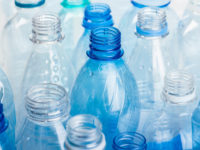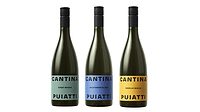Sustainability influencing future beverage packaging plans
Pandemic alters preferred beverage packaging options

Recycled PET (rPET) is among the packaging choices that beverage-makers are utilizing that align with eco-conscious consumers.
(Image courtesy of Keurig Dr Pepper)
For consumer packaged goods, sustainable packaging has evolved beyond a “buzzword” that people throw around to becoming part of the ethos for legacy and emerging brands. However, the future of this product attribute seems to hinge on brand owners better communicating the packaging’s sustainability aspects to consumers.
In a new survey by SK Group, which polled 1,500 U.S. adults in May on their attitudes about sustainable packaging, the research found that less than two-in-five Americans (38%) say they are completely confident they are recycling correctly at home.
Although consumers might be lacking confidence in their recycling habits, it does not mean that recyclable packaging is not important to them. Nearly three-quarters (72%) of Americans are likely to give preference to products that use packaging that can be easily recycled or reused, SK Group research found. Additionally, 74% of respondents in the 18-34 age group stated they are likely to purchase one product over another based on the product being eco-friendly.

Image courtesy of SK Group
Although a notable preference for recyclable containers remains present, the research also found that 42% of survey-takers said they were not aware that some recyclable containers, such as plastic bottles, cannot be recycled unless you first remove labeling and other packaging materials.
In its 2021 report “Beverage Packaging Trends – US,” Mintel also highlights consumer interest in sustainable packaging, but notes that its reach remains limited.
“Consumers as a whole generally only engage in simple sustainable behaviors such as recycling and want brands to make living sustainably as easy as possible,” the Chicago-based market research firm states. “In essence, consumers are drawn to products that offer easy-to-understand sustainable benefits, such as plastic bottles made from recycled plastics ― the use of rPET aligns with consumers’ high interest in recycling.”
Yet, Mintel also highlights the importance of eco-conscious consumers for brands as this group generally has higher incomes and shows a willingness to pay more for brands that align with their values.
“Strong sustainability claims resonate with the consumers who set future food and drink trends, making sustainable packaging claims a key differentiator and opportunity for new and emerging brands,” the report states. “Investments in sustainable practices now will pay off in the future.”
John Maddox, president of SBA-CCI Inc., Jacksonville, Fla., notes that lawsuits have emerged challenging that PET bottles might not be wholly recyclable, noting concerns raised about label materials and closures. He highlights solutions such as recyclable shrink wrap labels.
“The technology is already commercial for shrink labels that sink along with the PET in the reclaiming (washing) process,” he says. “This will both increase the yield of baled bottles and reduce the residue from reclaimers sent to landfill.

Image courtesy of TEN Alkaline Spring Water
“This would leave only the closure as a challenge, even though the polyolefin cap is totally recyclable and is regularly recycled as it is ground with the recycled bottles (with cap and label) and then floated off with typical paper and polypropylene-based CSD and water labels,” Maddox continues.
In terms of sustainable packaging investments, Maddox notes that various beverage-makers have shown a willingness to pay a premium for recycled PET (rPET) content as well as launching new products in aluminum packaging.
Mintel’s report also highlights the proliferation of aluminum packaging within beverages, but notes that its association as a sustainable package with consumers still has opportunities for education.
“The popularity of aluminum slim cans, the growth of aluminum bottles, and the expanded use of aluminum in the alcoholic beverage industry have placed a spotlight on the benefits of aluminum and driven its adoption among brands,” the report states. “Aluminum offers notable sustainability benefits, yet consumers largely view other beverage packaging types as being more environmentally friendly, indicating a need for brands and packaging manufacturers to educate consumers on aluminum’s sustainability credentials.”
With sustainable packaging commanding so much attention, SBA-CCI’s Maddox notes that this taken some focus away from new packaging solutions, particularly among non-alcohol brands.
“Package innovation is slowing and taking a back seat to the focus on environmental sustainability efforts and investments/expenditures,” he says.
Sizing up innovations
Despite sustainability driving much of the innovations among beverage packaging, the pandemic also has impacted package choices, experts note.
“The COVID-19 pandemic forever changed how consumers work, live and shop, and packaging must also evolve to address these changes in consumers’ lives,” Mintel’s report states. “Notably, the pandemic resulted in new opportunities for both larger and smaller packaging sizes.”
For larger pack sizes, the market research firm found that more 2020 meals were consumed at home, as well as the growing remote worker base.
The rise of online shopping also resulted in consumers’ increased interest in large pack sizes. “Fifty-four percent of consumers purchased groceries online during the pandemic compared to 32% who purchased groceries online pre-pandemic,” Mintel states. “Consumers tend to use online grocery retailers for larger stock-up trips, presenting brands with the opportunity to promote large pack sizes online.”
In terms of beverage alcohol, SBA-CCI’s Maddox prognosticates that more take-home consumption will remain present with COVID’s return. This could result in single-serve packaging that is larger than the traditional 12-ounce glass or can offerings.
“Perhaps even return to large ‘single-serve’ PET for beer,” he says. “Make it like a ‘growler’ to pour more than one while at home, but carry over that brew-pub, craft beer experience with the growler (in glass or PET).”
Although larger pack sizes have found favor during the pandemic, small pack sizes still have found new opportunities.
“While the economy as a whole is quickly recovering from the pandemic, unemployment remains high, indicating the opportunities for smaller (e.g., dollar store sized), budget-friendly pack sizes,” Mintel’s report states.
The market research firm also notes that small pack sizes allow health-conscious consumers to indulge, keeping them engaged in a category versus leaving altogether. It notes the new 13.2-ounce bottle size that The Coca-Cola Co. unveiled earlier this year as well as Monster Energy releasing 12-ounce can sizes.
As beverage-makers look to engage with consumers, packaging attributes look to be taking a greater focus.
Looking for a reprint of this article?
From high-res PDFs to custom plaques, order your copy today!







